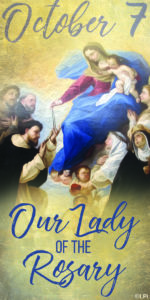 by Fr. Steve Baumann.
by Fr. Steve Baumann.
This past week the universal Church celebrated the Memorial of Our Lady of the Rosary. This feast has a long history, going back to 1573 when Pope St. Pius V established it in gratitude to God for the defeat by Christians of the Turks at Lepanto – a victory credited to the praying of the Holy Rosary.
The Rosary itself, as we know it in five decades of ten Hail Mary’s, the Our Father, the Glory Be’s and the Fatima Prayer, developed over a long time historically. At first there was the practice of praying one hundred fifty Our Father’s, in imitation of the 150 Psalms. Next developed a parallel practice of praying 150 Hail Mary’s, with the attachment of mysteries of Jesus’ life to each Hail Mary.
The legend of Mary’s giving the Rosary to St. Dominic, while not proven, is likely true, and the popularization of this prayer form owes much to the Dominicans (Order of Preachers), both men and women religious. One Dominican Saint, Alan de la Roche, founded a Confraternity of the Rosary, mainly for lay people, in the fifteenth century, and he became known as “The Apostle of the Rosary.”
By the sixteenth century, the Rosary began to take on its present form, to include fifteen mysteries – the Joyful, Sorrowful, and Glorious – until St. John Paul II introduced his additional five Mysteries of Light (Luminous Mysteries) in 2002.
All the mysteries are presented for our meditation – from the Annunciation to Mary (for which our parish is named), to the paschal mysteries (the life, death, and resurrection of Jesus) that celebrate His triumph over sin, the foundation upon which our faith is built, and through which we proclaim the love of God for all people.
Father James J. Flood (To Preach, To Teach, To Pray Mary, p. 41) states “The Rosary focuses upon Christ and upon the intimate relationship which Mary enjoys with her Son, and so it is adaptable to the prayer life and spiritual needs of all persons within the Mystical Body of Christ.”
The Second Vatican Council in the Constitution on the Sacred Liturgy reminds us that our devotions “should be in accord with the sacred Liturgy, should in some way be derived from it, and lead the people to it.” (n. 13) The Rosary does this because it is in harmony with the liturgical seasons and feasts; it recalls the great mysteries, and so is rightly honored in the Church.”
The main focus of the Rosary is on Jesus – his birth, life, death, and resurrection for us. The Our Fathers at the head of each decade remind us that God the Father is the initiator of our salvation. The Hail Mary’s remind us to join Mary in contemplating these mysteries, as she was most intimately joined to her Son in all aspects of His life, then and now. And the Glory Be’s to God remind us that the purpose of our lives is to give glory to the Holy Trinity. The simple repetition of the prayers help us to focus on the mysteries, and we can sense that Mary and Jesus are with us in the joys and sorrows of our lives. We can hope that our merciful God will bring us one day to share in the glory of Jesus and Mary forever.
As we daily pray the Rosary mysteries with love for Our Lady and her Son, may we “imitate what they contain, and obtain what they promise.”
